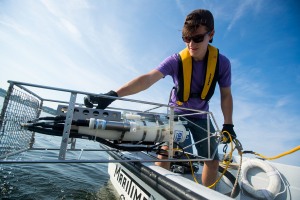PROVIDENCE, R.I. [Brown University] — Whether it’s how airplanes take off and land or how they cruise in the air even through turbulent conditions, one thing has always been a constant for Anoop Kiran: a love of all things aviation and aerodynamics. And this summer is no different.
Each day, the Brown University Ph.D. student finds himself delving deeper into this passion by performing experiments on a pair of drones he mounts onto a metal fixture, one above the other, to closely analyze what happens when drones fly too close together.
“In this case, the upper drone impinges downwash — which is this downward force — affecting the stability of the lower drone,” said Kiran, who this fall will start his second year at Brown’s School of Engineering as part of the fluids and thermal sciences research group. “The downwash effect causes a catastrophic loss of control and prevents drones from being able to fly close together as a team.”
